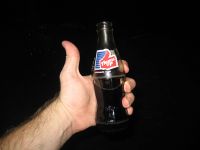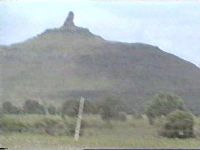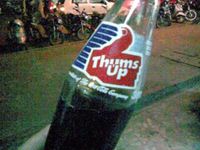Thums Up
 |
|
| Type | Cola |
|---|---|
| Manufacturer | The Coca-Cola Company |
| Country of origin | India |
| Introduced | 1977[1] |
| Related products | Coca-Cola, Pepsi, Campa Cola |
Thums Up is a carbonated soft drink (cola) popular and largest selling brand in India,[2] where its bold, red thumbs up logo is common. It is similar in flavour to other colas but has a unique taste reminiscent of betel nut. Introduced in 1977 to offset the expulsion of The Coca-Cola Company and other foreign companies from India, Thums Up, Limca, and Campa Cola gained nationwide acceptance. The brand was bought out by Coca-Cola which, after unsuccessful attempts at killing the brand, later re-launched it in order to compete against Pepsi.
Contents |
Background

During the late 1970s, the American cola giant Coca-Cola abandoned operations in India rather than make a forced sale of 60% of their equity to an Indian company.[3] Following this, the Parle brothers, Ramesh Chauhan and Prakash Chauhan, along with then CEO Bhanu Vakil, launched Thums Up as their flagship drink, adding to their portfolio of older brands Limca (lime flavor) and Gold Spot (orange flavor). Thums Up was basically a cola drink, but the company never claimed it as such. The formula was just as closely guarded as the famous Coke formula. During the same time, the owners of Coca-Cola’s bottling plant, Pure Drinks Ltd., launched Campa Cola and Campa Orange, both of which had a higher dose of carbon dioxide.


The Thums Up logo was a red 'thumbs up' hand gesture with a slanted white sans-serif typeface. This would later be modified by Coca-Cola with blue strokes and a more modern-looking typeface. This was mainly done to reduce the dominant red color in their signage. The picture shows the Thums Up mountain or, Thums Up pahaad (in Hindi), Manmad hills which has a natural top like the thums up logo and is a popular sight from trains. Its famous caption until the early 1980s was, “Happy days are here again”, coined by then famous copywriter Vasant Kumar, whose father was spiritual philosopher U. G. Krishnamurti. The caption became "I want My Thunder." It is currently "Taste the thunder!"
Thums Up enjoyed a near monopoly with a much stronger market share often overshadowing its other rivals like Campa cola, Double seven and Dukes, but there were many small regional players who had their own market. It even withstood liquor giant United Breweries Group (makers of Kingfisher Beer) Mcdowell's Crush, which was another Cola drink, and Double Cola.
It was one of the major advertisers throughout the 1980s. In the mid-80’s it had a brief threat from a newcomer Double Cola which suddenly disappeared within a few years.
In 1990, when the Indian government opened the market to multinationals, Pepsi was the first to come in. Thums Up went up against the international giant for an intense onslaught with neither side giving any quarter. With Pepsi roping in major Indian movie stars like Juhi Chawla, to thwart the Indian brand, Thums Up increased its spending on Cricket sponsorship. Then the capacity went from 250ml to 300ml, aptly named MahaCola. This nickname gained popularity in smaller towns where people would ask for "Maha Cola" instead of Thums Up. The consumers were divided where some felt Pepsi’s mild taste was rather bland.
In 1993 Coca-Cola re-entered India after a prolonged absence from 1977 to 1993. But Coca-Cola’s entry made things even more complicated and the fight became a three-way battle. That same year, in a move that baffled many, Parle sold out to Coke for a meagre US$ 60 million (considering the market share it had). Some assumed Parle had lost the appetite for a fight against the two largest cola brands; others surmised that the international brands seemingly endless cash reserves psyched-out Parle. Either way, it was now Coca-Cola’s, and Coke has a habit of killing brands in its portfolio that might overshadow it. Coca-Cola soon introduced its cola in cans which was all the rage in India, with Thums Up introduced alongside, albeit in minuscule numbers. Later Coca-Cola started pulling out the Thums Up brand which at that time still had more than 30% market share.
Re-launch
Despite its strong overall equity, the brand was losing its popularity among the core cola drinking age group of 12 to 25 year olds, partly due to nil advertising.
Coca-Cola apparently did try to kill Thums Up,[4] but soon realized that Pepsi would benefit more than Coke if Thums Up was withdrawn from the market. Instead, Coke decided to use Thums Up to attack Pepsi. The Coca-Cola Company by this time had about 60.5% share of the Indian soft-drink market [1] but much to its dismay found out that if it took out Thums Up, it would remain with only 28.72% of the market (according to a report by NGO Finance&Trade in India), hence it once again dusted out the Thums Up brand and re-launched it targeting the 30 to 45 year olds.
The brand was re-positioned as a “manly” drink, drawing on its strong taste qualities.[5] Known to be a strong drink with more power packed into it than other colas, it was a favorite in Rum based Cocktails, as in “rum and Thums Up.” Thums Up kick-started an aggressive campaign directly attacking Pepsi’s TV ads, focusing on the strength of the drink hoping that the depiction of an “adult” drink would appeal to young consumers. “Grow up to Thums Up” was a successful campaign. The brand’s market share and equity soared. The brand was unshakeable and Coca-Cola’s declaration that Thums Up was India’s premier cola brand in terms of market share did not surprise many.[6]
Other campaigns from Thums Up build on its “strength” and its perception as a macho drink.[7] Ads showing the Thums Up man, riding through the desert in search of a cantina that sells Thums Up rather than drink another cola, stuck in the minds of many Indians and caught the imagination of youngsters who want to be seen as men.
Sponsorship
Thums Up was a major sponsor of cricket matches. In the early 1980s, it came out with several postcards featuring Sunil Gavaskar and Imran Khan. Besides cricketers, Thums Up's celebrity endorsers include Akshay Kumar and Salman Khan popular south Indian actors Megastar Chiranjeevi and Mahesh Babu. Besides this, Parle’s southern bottler was a major sponsor of Indian motorsport in the 80s. In addition to sponsoring several Indian track drivers in Sholavaram races, they sponsored several regional car and bike rallies.
References
- ↑ http://www.coca-colaindia.com/brands/brands_thumsup.aspx
- ↑ http://economictimes.indiatimes.com/news/news-by-industry/services/advertising/Coke-Indias-new-Thums-Up-ad-most-expensive-ever/articleshow/5421850.cms
- ↑ International Marketing & Export Management Albaum.G and Duerr.E. 6th Ed 2008. Pearson p.265
- ↑ http://www.brandchannel.com/features_profile.asp?pr_id=211
- ↑ http://businesstoday.intoday.in/index.php?option=com_content&task=view&id=11370
- ↑ http://www.mercurybrief.com/2009/10/thums-up-cola-of-india/
- ↑ http://www.ormaxworld.com/case-studies.php
External links
|
||||||||
|
|||||||||||||||||